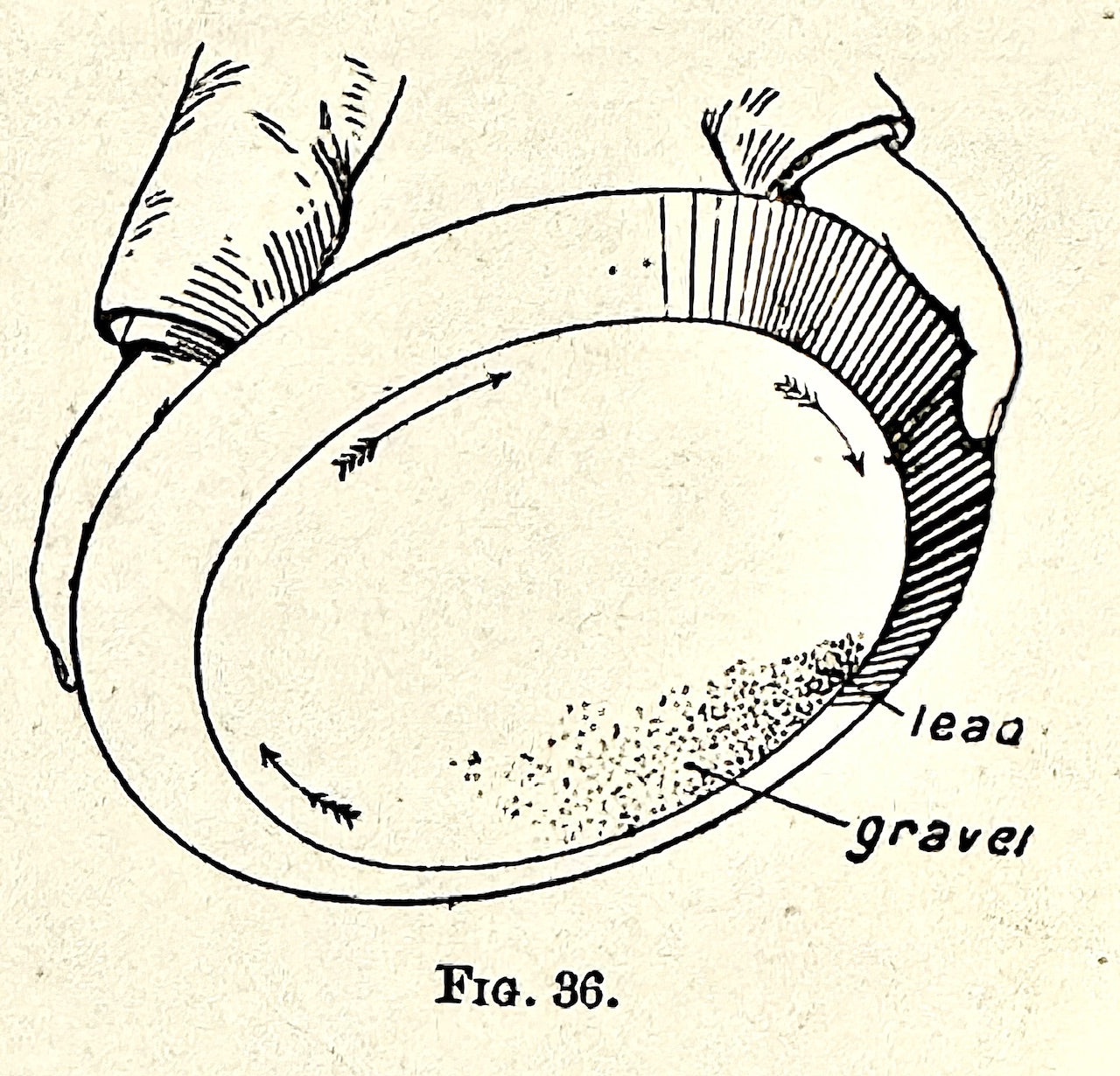
The Prospectors Handbook: Conditions Where Gold Is Usually Found PART 3
Searching for minerals (Lead, Silver, Gold, TIn, Platinum, Copper, etc.) will want to identify them primarily by their color, luster, and possibly streak to properly characterize them. Harness and specific gravity are difficult to obtain from rough specimens.
Testing is important because minerals can be disguised by the presence of things like iron oxide, causing the prospector to think that the specimen is a useless rock.
It is of the utmost importance for the prospector to make himself familiar with various oxides, and to a lesser degree with carbonates and chlorides. The sulfides which are found deep down in a lode become converted to oxides on the surface.
For instance, a lode where Pyrite and Iron Pyrites exist way down deep. On the outcrop (surface) there would probably be the rusty color due to iron oxide; Black Oxide (perhaps the red)of copper, and also the green or bluish stain of carbonate of copper might be distinctly noticed.

Copper
In a copper-bearing lode the black oxide, sometimes red oxide, and green carbonate, may be noticed in the cavities of the surface quartz.
Native Copper
- Native copper is often found in tree-like, mosslike, threadlike shapes, in octahedral crystals, and grains
- Color: Red
- Ductile & Malleable
- Hardness: 2.5-3
- Specific Gravity 8.5-8.9
- Usually carries silver
- Found Chiefly in North and South America, also in Cornwall, Wales
Copper Glance (Vitreous Copper Ore)
- Crystallization: Rhombic prisms. Is slightly sectile
- Color: Blackish gray, tarnishing to blue or green
- Streak: Blackish Gray, sometimes shining
- Hardness: 2.5-3
- Specific Gravity 5.5-5.8
Copper Pyrites (Chalcopyrite)
- Crystallization: tetrahedral, also massive
- Color: brass yellow, sometimes tarnished and iridescent
- Streak: Greenish black and unmetallic
- Hardness 3.5-4
- Specific Gravity 4.15
Gray Copper (Tetrahedrite)
- When containing silver, Fahlerz
- Crystallization: Tetrahedral
- Structure: Brittle
- Color: Between steel gray and iron black, sometimes brownish
- Hardness: 3-4
- Specific Gravity: 4.75-5.1
Red Copper Ore (Ruby Copper)
- Found massive, earthy, granular
- Crystallization: Octahedral, and dodecahedral
- Structure: Brittle
- Luster: Adamantine, or submetallic. Is subtransparent or nearly opaque. Detached Crystals look rather like Spinel Rubies
- Color: Deep red, ruby color, though it is often iron gray on the surface
- Streak: Always brownish red
- Hardness 3.5-4
- Specific gravity 6
Black Oxide of Copper
Usually found on the surface due to the decomposition of a sulfide or other copper ore. Black copper on the surface of a lode may indicate some other copper compound deeper down.
Silicate of Copper
- Usually as an incrustation, massive
- Color: Bright green and bluish green. Similar to malachite in color.
- Hardness: 2.3
- Specific Gravity 2-2.3
Malachite (Green Carbonate of Copper)
- Found in Botryoidal or stalactitic masses, and as an incrustation
- Structure: Fibrous
- Nearly opaque
- Color: Emerald Green
- Streak: A paler green than the actual color
- Hardness: 3.5-4
- Specific Gravity: 3.6-4
Deposits in North America
In the Eastern States there are deposits in the New Red Sandstone, also in the Carboniferous Limestone and Silurian rocks.
In Lake Superior district, where so much native copper is found, deposits occur in sandstones and shales, underlying greenstone. There are also lodes running through various strata.
Deposits of Ruby Copper Ore occur in Arizona between Quartzose and Hornblendie rocks and limestone.
Lodes and deposits in Chili are worked in hornblendie and feldpathic quartz rocks.
The celebrated Burra Burra Mine in Australia, from which magnificent lumps of malachite are familiar objects in museums, consists of an immense irregular deposit of malachite and other copper ores in limestone and harder rocks, as well as in the soil.

Gold
Examining free or native gold should be done with a magnifying glass. The particles of gold, if present, should be easily distinguishable by an expert from mica, iron, or copper pyrites.
Indeed sometimes gold looks like not very yellow iron pyrites. However, gold presents the same color from whatever direction it is looked at. (Editors note: Gold will remain the same color in the shade or sun, while pyrite will change).
A gold grain can be flattened out by hammering and can be cut in slices, whereas those substances likely to be mistaken for gold are reduced to powder when pounded.
Iron Pyrite is too hard to be cut by a knife. While copper pyrite produces a greenish powder. Pyrite ore, when heated, gives off a sulphury odor.
Mica, which when discolored may be frequently mistaken for gold, is not capable of being cut smoothly with a knife, and has a colorless streak.
A speck of gold is not altered by a drop of hydrochloric acid.
Determining how much microscopic gold is in a rock specimen is usually done by means of scorification or fusion in a crucible, and afterwards by the cupellation process.
It must be remembered that frequently the gold occurs in a fine powder, invisible to the eye or even under a lens. Also that gold grains–probably due to sulfur of arsenic–may be coated with a film, which prevents them from being recognised, and also from being capable of amalgamation with mercury until they have been roasted or undergone some operation.
Panning Gold

To pan out gold-bearing matter, the gravel, sand, or not-too-finely powdered rock, is placed in a flat bottomed basin or pan, the diameter of which is about a foot, and two or three inches wider at the top than at the bottom.
The pan, three-quarters full of ore, should be placed at an inclined position under water, or else water poured into it, and by shaking and agitating the contents of the pan by a kind of oscillatory motion, the lighter portions of the ore are allowed to run over the side of the vessel, until, after much washing, the heavier particles, such as gold, iron sand (magnatite) settle to the bottom.
The iron sand, if magnetic, can be separated from the gold by a magnet, or else can, when dry, be blown away by a gentle blast of air.
The wooden vessel, called in Brazil a Batea, serves the same purpose as a pan.
For practicing, place some fine lead (or copper or iron pyrites) with a good quantity of gravel or sand in the pan. Wash the whole with water so that all soluble or easily suspended matter may be got rid of, and thereby the separations may be more clearly observed.
Now fill the pan with a fresh supply of water, and shake the whole round about, and chiefly down from side to side, several times, to allow the heavier matter to settle down and out of view underneath the gravel.
By tilting the pan a little away from the body (35-45 degrees depending on how full the pan is), and still shaking it side to side, the lead will seek the lowest level, and the water water may be made to wash some of the gravel over the rim.
By repeating the process, shaking side to side, then pulling the pan back toward you to allow the gravel to wash off the top, a skillful operator will be able to get rid of all the matter except the lead (or whatever heavy material was used).
 Once only the ‘heavies’ are left in the pan, one can swirl the water around one direction over the surface of the material to get the remaining gravel off and expose the heavy metals beneath it.
Once only the ‘heavies’ are left in the pan, one can swirl the water around one direction over the surface of the material to get the remaining gravel off and expose the heavy metals beneath it.
Native Gold
Found as grains; laminae; sometimes threadlike; nuggets. THere is always a small amount of silver in the gold, in California around 10%.
Gold, nearly invariably in a native state, is very widely distributed over the globe, and is obtained from the gravel, sand, clay, “drift beds”, washed down from gold-bearing strata (sometimes the rich part of the deposits has brown ferrunginous matter associated with it), or else from quartz lodes traversing the older slatey and metamorphic rocks and less abundant granite.
It is also found scattered about in rocks of granular nature. The ordinary gold-bearing lodes and deposits occur as represented in Fig 37, which represents the structure of the Ural Mountains (Russia).
 Iron pyrites, copper pyrites, magnetic iron, blende, and galena are some of the metallic minerals often very commonly associated with gold in a lode, the iron pyrites in veins of a gold-bearing district nearly, if not always, containing a certain amount of gold.
Iron pyrites, copper pyrites, magnetic iron, blende, and galena are some of the metallic minerals often very commonly associated with gold in a lode, the iron pyrites in veins of a gold-bearing district nearly, if not always, containing a certain amount of gold.
On the surface of a lode the gold specks (not mica or pyrite) may be noticed, by the eye or lens, in the cavities of the brown honeycombed quartz rock, although free gold may be invisible in they pyrites rock deeper in the lode and unexposed to atmospheric and other changes affecting the surface portions.
Gold has also been discovered in unusual circumstances. It has been profitably obtained in sinter, trachyte, and very peculiar conglomerates.
Usually the discovery of alluvial gold leads to that of lodes in the neighborhood; but because gold deposits are not found, it does not mean that the country is non-gold-bearing. So too, just because gold is not noticed in the outcrop of a lode does not mean that the lode is necessarily an unprofitable one.
In alluvial deposits gold grains are usually worn into shape, and in some other deposits. But in certain conglomerates the gold is found in thin plates, a fact which suggests that the law of gravity does not apply to the distribution of metal in these at it usually does in most deposits where the portions nearest the bedrock are richest.
Here, too, it may be mentioned that in conglomerates, such as the South African, the gold is not chiefly in the pebbles, but in the matter that binds them together.
Gold has been found all throughout Europe, sometimes in muds and sands of rivers, and consequently some parts of the hill districts through which they pass through.
Austro-Hungary is rich in lodes (the gold being sometimes found as a telluride, a telluride is a type of mineral that is similar to sulfides, for instance Altaite), and the extent of the gold-bearing alluvial deposits of the Ural Mountains is enormous (fig 37).
THere are lodes in the British Isles and parts of Scotland, Ireland, Cornwall, Devon, and Wales some of which were worked by the Romans. The gold-rich quartz reefs (carrying iron pyrites, galena) run through slates of old fossilferous rocks (lower & upper Cambrian) and at the intersection of these gold bearing lodes with other copper and silver bearing ones the reefs are sometimes rich.
The following diagram exemplifies the postion of a gold-rich "gutter" where the bed of an ancient stream has collected various gravels over time, the Auriferous (gold-rich) part being at the very bottom where the 1, 1, 1 are located (at the bottom of each ripple).

In contrast, in California, in extensive alluvial deposits at the base of the Sierra Nevada mountains, in the beds of modern and ancient streams, in magnetic iron sand, in lodes through granite, gneissic and other metamorphic rocks, in seam diggings of decomposed bedrock with irregular seams of gold-rich quartz.



